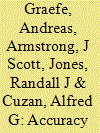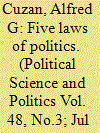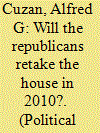| Srl | Item |
| 1 |
ID:
131686


|
|
|
| 2 |
ID:
140222


|
|
|
|
|
| Summary/Abstract |
Drawing on more than 500 elections from around the world, this article presents five empirical laws of politics. Four of these laws span democracies and dictatorships, and one sets a boundary between the two. In both regimes the governing party or coalition represents a minority of the electorate. In democracies this minority usually represents a plurality that amounts to about one third of the electorate. Judging by the outcome of the first free elections in regimes undergoing a transition, there is reason to believe that in dictatorships the minority is much smaller. Even as they have an advantage over the opposition, the incumbents experience an erosion of support over time. In democracies this leads to alternation in office, which in turn ensures that across many elections about two-thirds of the electorate gets to see its favorite party or coalition in government from time to time. In dictatorships, during long periods in office, support for the ruling party shrinks to insignificance. Also in democracies, it is rare for incumbents to receive more than 60 percent of the vote, and it never happens twice within the same spell in government. This appears to be a reliable indicator that differentiates all democracies from most dictatorships. The conclusion is inescapable—the dictatorial “passion for unanimity” and illusion of “organic unity” notwithstanding, the state is a plurality. The will of the electorate emerges as a result of competition among political parties.
|
|
|
|
|
|
|
|
|
|
|
|
|
|
|
|
| 3 |
ID:
116462


|
|
|
|
|
| Publication |
2012.
|
| Summary/Abstract |
In March 2009, at a time when President Obama was basking in the glow of the honeymoon with the public every new president enjoys, I asked, "Will Barack Obama be a one-term president?" What prompted me to pose so impertinent a question at so hopeful a time was that the Office of Management and Budget was projecting that that year the federal government would spend 28% of gross domestic product (GDP). This amounted to a 7% point increase compared to the previous year, the largest peacetime one-year jump since 1930. The most recent estimate for 2012 is that federal outlays will take up 24.3% of GDP, up 3.5% points since 2008. This is the second-largest peacetime increase from one election year to the next since 1880, edged out only by Franklin D. Roosevelt's first-term surge of 3.6% points.
|
|
|
|
|
|
|
|
|
|
|
|
|
|
|
|
| 4 |
ID:
100779


|
|
|
|
|
| Publication |
2010.
|
| Summary/Abstract |
Historically, statistical models for forecasting the outcome of midterm elections to the United States House of Representatives have not been particularly successful (Jones and Cuzán 2006). However, in what may have been a breakthrough, most models correctly predicted that the Democrats would re-emerge as the majority party in 2006 (Cuzán 2007). One successful model was estimated using 46 elections, beginning with 1914 (only the second time that 435 representatives, the present number, were elected). The model was relatively simple, making use of national-level variables only (Cuzán and Bundrick 2006). Using a similar model, I generated a forecast for the 2010 midterm election.
|
|
|
|
|
|
|
|
|
|
|
|
|
|
|
|